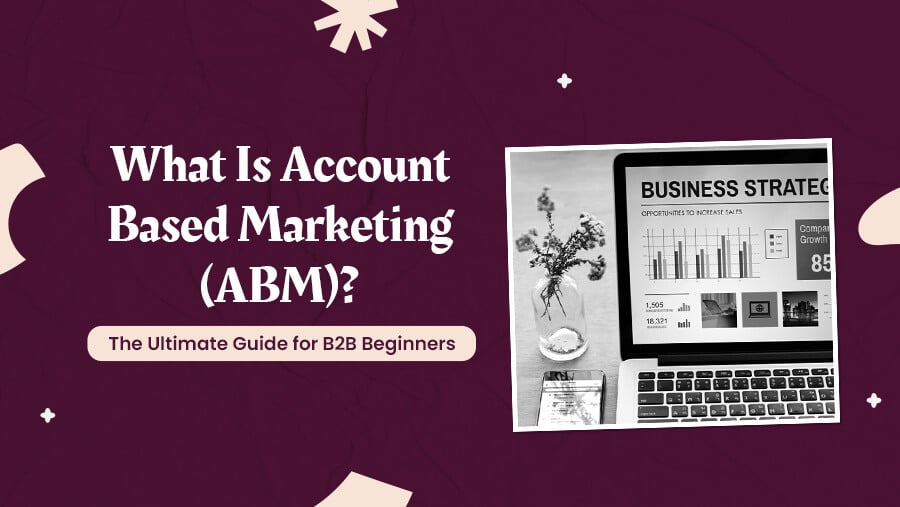
What Is Account-Based Marketing (ABM)? The Ultimate Guide for B2B Beginners
Imagine focusing your marketing efforts not on casting a wide net but landing the biggest fish—those high-value clients that can transform your business.
Account-based marketing (ABM) does that, flipping the traditional marketing playbook by concentrating on the accounts that matter most and delivering personalized, high-impact campaigns tailored to their needs.
In today's crowded B2B landscape, standing out means being relevant, and ABM is the strategy that has proven to work. A study by ITSMA found that 87% of marketers report higher ROI with ABM than with any other approach.
But how do you harness the power of ABM in an era driven by data, AI, and hyper-personalization? This blog will walk you through cutting-edge strategies to help you identify, engage, and convert high-intent leads with laser-focused precision—elevating your sales pipeline and positioning your brand as a go-to solution for top-tier clients.
Understanding Account-Based Marketing (ABM)
What is ABM?
Account-based marketing (ABM) is a personalized strategy that targets individual accounts (companies) rather than marketing to a broad audience. Instead of a "spray-and-pray" approach, ABM focuses on a select few high-intent accounts with the potential to generate the most revenue.
Let's say you sell enterprise-level software. With ABM, instead of marketing to every business in your industry, you identify 10-20 companies that perfectly match your Ideal Customer Profile (ICP)—think Fortune 500 firms that would benefit from your solution. You then create custom content and campaigns explicitly targeting those organizations' decision-makers.
What is Account-Based Marketing (ABM)?
Account-based marketing (ABM) is a highly personalized marketing strategy focusing on individual accounts (companies) rather than casting a wide net for leads.
Unlike the traditional "spray-and-pray" approach, where marketing efforts are aimed at a large audience to catch a few potential customers, ABM hones in on a specific set of high-value, high-intent accounts with the tremendous potential to generate significant revenue.
- ABM allows businesses to create tailored marketing campaigns for each account, addressing their unique challenges, needs, and goals.
- It is a strategy that focuses on quality over quantity.
- It ensures that the efforts put into marketing are directed toward the accounts that are most li
- kely to convert and have the biggest impact on the bottom line.
Imagine your company sells enterprise-level software solutions. Instead of marketing to every business in your industry, ABM would have you-

ABM vs. Traditional Marketing

While traditional marketing focuses on volume, ABM centers on high-quality interactions with fewer, more valuable accounts.
Core Elements of ABM for Lead Targeting Success
Identifying High-Value Target Accounts
The key to ABM's success starts with choosing correct accounts to target. It’s not about reaching the most companies but the right ones.
To do this, you’ll need to rely on solid data to identify which companies are the best fit for your product or service.
- Fit: Does the company align with your ICP?
- Intent: Are they showing signs of buying interest (search activity, downloads, etc.)?
- Opportunity: Does the account have a clear, urgent need for your solution?
For instance, if you’re targeting enterprise software buyers, tools like Bombora can provide intent data—showing which companies are actively researching topics related to your solution. This helps you prioritize accounts that are already in the market.
Building a Unified Sales & Marketing Alignment
According to Marketo, companies that align their sales and marketing teams are 67% better at closing deals. ABM requires seamless collaboration between these two teams to deliver a unified experience across all touchpoints.
Pro Tip: Hold regular meetings between sales and marketing teams to track progress on high-value accounts, share insights, and fine-tune messaging.

Innovative Approaches to Lead Targeting in ABM
1. Leveraging AI and Data Analytics
Using AI tools, companies can increase lead targeting precision. 60% of B2B marketers say that AI-powered ABM helps them better identify key accounts that are more likely to convert (Demandbase).
AI tools like 6sense and Drift can analyze real-time buyer behavior and recommend the best time to engage.
2. Intent Data and Predictive Targeting
Intent data helps marketers prioritize leads with strong buying signals. For instance, if a company consistently downloads whitepapers on cloud solutions, intent data tools will flag this as a potential high-intent lead.
A tech firm using intent data tools found that 30% of its leads actively searched for cybersecurity solutions. By prioritizing outreach to these leads, the firm increased its conversion rate by 25% in just six months.
3. Hyper-Personalization at Scale
Balancing personalization with efficiency can be challenging. However, marketing automation platforms like HubSpot allow businesses to scale outreach while delivering personalized messaging.

4. Tech Stack for ABM
To run an efficient and effective ABM strategy, you need the right combination of tools to manage and coordinate your sales and marketing efforts seamlessly. Here’s a breakdown of the critical components of a robust ABM tech stack:

By integrating CRM, Marketing Automation, and Account Targeting Platforms, you can create a unified ABM strategy that targets the right accounts, engages them with personalized content, and tracks the entire customer journey—from first interaction to closed deal.
Tactical Lead Targeting Methods in ABM
Multichannel Engagement Strategies
ABM requires you to reach target accounts across multiple platforms, including email, social media, direct mail, and events. The key is consistent messaging.
A company targeting enterprise buyers launched an ABM campaign that combined LinkedIn ads with email outreach, custom landing pages, and personalized direct mail. The multichannel approach led to a 40% increase in meeting bookings.
Orchestrating Targeted Outreach Campaigns
When designing an ABM outreach campaign, start with in-depth research into each account. Tailor your messaging to specific pain points and business challenges.
A SaaS company created custom case studies for each target account, showing how their product solved similar challenges for businesses in the same industry. This approach boosted conversion rates by 20%.
Personalized Content & Experiences
Develop content specifically for your target accounts, such as personalized case studies, demos, and webinars.
Measuring the Success of ABM Lead Targeting
Key ABM Metrics to Track
Critical metrics for ABM success include:
- Pipeline Growth: Track the new opportunities created from your target accounts.
- Account Engagement: Measure email opens, content downloads, and meeting bookings.
- Deal Velocity: Monitor how quickly target accounts move through the pipeline compared to non-targeted accounts.
Companies implementing ABM experience 208% more revenue from their marketing efforts than companies that don’t adopt an ABM strategy (Forrester).
Account-Based Reporting
Account-based reporting helps you track progress on individual accounts, demonstrating the ROI of ABM. Use these insights to optimize your campaigns continuously.
Key Benefits
- Track Account Metrics: Monitor each account's engagement, pipeline growth, and revenue.
- Prove ABM ROI: Demonstrates how ABM contributes directly to revenue growth.
- Refine Campaigns: Real-time data allows for continuous optimization of targeting and messaging.
- Align Sales and Marketing: Improves collaboration by focusing on high-value accounts.
- Personalize Outreach: Tailors messaging based on insights into decision-maker preferences.
- Efficient Resource Allocation: Identifies high-revenue accounts for focused effort.
This approach ensures that your ABM strategy becomes more data-driven, efficient, and effective.
How to Overcome Challenges in ABM Lead Targeting
Businesses need a strategic and balanced approach to overcome the challenges in Account-Based Marketing (ABM) lead targeting. Here's a step-by-step guide to addressing common pitfalls:
1. Overcome Overpersonalization
While personalization is a crucial aspect of ABM, overpersonalization can lead to inefficiency. To avoid this:
▢ Prioritize Key Accounts
▢ Develop Tiered Personalization
▢ Leverage Technology
2. Solve Lack of Sales-Marketing Alignment
Misalignment between sales and marketing can result in inconsistent messaging and missed opportunities. To overcome this:
▢ Collaborate Early and Often
▢ Shared Goals and KPIs
▢ Account-Specific Playbooks
3. Addressing Scalability Issues
Scaling ABM can be difficult as the number of target accounts grows. To maintain effectiveness while expanding:
▢ Use Data-Driven Insights
▢ Adopt Technology for Efficiency
▢ Cluster Accounts
▢ Create Reusable Assets
4. Staying Data-Driven and Focused on Scalability
Balancing automation and personalization is essential for keeping ABM efforts efficient without sacrificing the personal touch.
▢ Data Integration
▢ Test and Optimize
▢ Automate Low-Value Tasks
By implementing these steps, you’ll avoid common ABM pitfalls and create a scalable, efficient process that drives results.
Conclusion
Account-based marketing (ABM) is revolutionizing how businesses engage high-value clients. With advanced strategies like AI, intent data, and hyper-personalization, companies can enhance their ABM efforts, delivering more targeted, impactful campaigns. These tech-driven tools enable better alignment with buyer needs and boost ROI.
Ready to elevate your ABM strategy?

.jpg?width=60&name=deepti%20(2).jpg)


